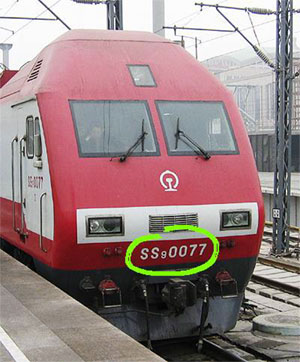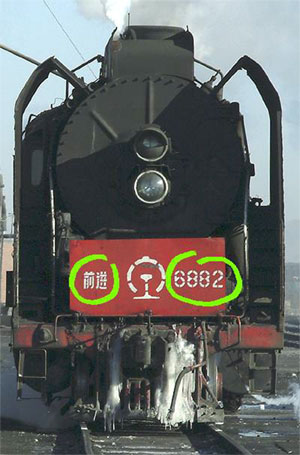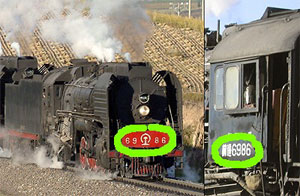A Guide to the Chinese Numbering System
China has a national numbering system for standard gauge locomotives, irrespective of whether they work on the national system, on local railways or industrial lines. Each number consists of two parts; a class designation and a running number. At the highest level the system adopted by Chinese railways is similar to that used in most European countries and the former Soviet Union. The difficulty for western observers is that the class designation is often written in Chinese characters which many enthusiasts find difficult to read and are tempted to ignore.
The class designation is important as running numbers are often duplicated between classes. Beijing Railway Museum contains around 5 locos with the running number 0001 and there are numerous other examples out on the system! The running number on its own is not enough to identify a particular locomotive.
Some locos carry their class name in Chinese characters, others use the more easily recognisable two or three letter abbreviations. Sometimes locos appear to only have a running number but it's usually possible to find the full number somewhere on the engine. The cabside is usually a good place to start.
The numbering system currently in use had its origins in pre-war, Japanese controlled Manchuria. Classification was by type (wheel arrangement) and was originally represented by a pair of Japanese Katakana characters, often a crude transliteration of the common American name for that wheel arrangement. Hence 2-10-0s, or decapods, became "TeKa" which was as close as Katakana could get to deca. Similarly 2-6-0s, or moguls, became "MoKa", mikados became "MiKa" and so on. Some names were less easy to deduce, such as pacifics (4-6-2) which became "HaShi" or consolidations (2-8-0) which became "SoRi".
After the liberation, China found itself with over 4000 locos of almost 200 different classes from a multitude of builders. In 1950, a unified system was adopted for the whole country using the national phonetic alphabet to replace the Japanese characters but retaining the same pronunciation. A second change occurred in 1959 when the phonetic letters were replaced by their roman equivalents, so 2-10-0s became DK. Similarly 2-6-0 moguls became MG, 2-6-2 prairies became PL and so on.
At the same time, more patriotic Chinese names were introduced for the most common types. Each name had a two-letter abbreviation, formed from the first letter of the Pinyin transliteration of each character in the Chinese name, which could be used as an alternative. So mikados became 解放, Jie Fang or JF, meaning "Liberation", instead of MK. Similarly pacifics became 胜利, Sheng Li or SL, meaning "Victory". New locos under construction also received Chinese names. The new mikados were classed 建设, Jian She, or "Construction" and the new pacifics 人民, Ren Min, RM or "People".
The 1950 renumbering also introduced the subdivision of types into individual classes dentoted by a numeric suffix and this was retained with the 1959 changes. For example, the Manchurian standard 2-8-2s became JF, the three-cylinder Manchurian engines JF2, the Skoda locos JF3 etc. Running numbers were allocated so there was no overlap between locos of the same basic type, so JF 1 to 2500 were followed by JF2 2501 to 2550, JF3 were numbered from 2551 to 2602 and so on. The new JS 2-8-2s started at 5001, after the last JF number and the new pacifics at RM 1001 after the last SL. There was overlap between locos of different types. For instance, there was a JF 1, an SL1 1, a DK1 1 etc.
New classes introduced from the late 1950s tended to start at 0001 irrespective of whether they were of the same wheel arrangement as existing classes. This applied to the 和平, He Ping, HP or "Peace" class 2-10-2s and the 上游, Shang You, SY or "Reach Upward" class 2-8-2s. Interestingly the production QJ class started at QJ 101, not QJ 0101.
The HP classification was changed to 反帝, Fan Di, FD or "Anti Imperialist" during the cultural revolution before changing to the more familiar 前进, Qian Jin, QJ or "Advance" class in 1971. Rather confusingly, the ex-Soviet FD class 2-10-2s, known then as 友好, You Hao, YH or "Friendly" class were renamed 反修, Fan Xiu, FX or "Anti-Revisionism" class during the cultural revolution before losing their Chinese name and becoming plain FD class in 1971.
This should have ensured a unique number for every loco in the country but some industrial establishments have renumbered their engines, often duplicating existing numbers and leading to confusion. Fortunately, most have stuck with the national scheme.
Early diesels adopted the same arrangement with imaginative names like 巨龙, JuLong or "Great Dragon" and 卫星, WeiXing or "Satellite" for the first prototypes built around 1958. By the time series production began in the mid 1960s, the names 东风, DongFeng, DF or "East Wind" and 东方红, DongFangHong, DFH or "The East is Red" had been standardised for domestically produced diesel-electrics and diesel-hydraulics respectively. Subsequent production has followed this pattern which doesn't clearly distinguish between shunting engines, such as the DF2 or DF5, heavy freighters such as the DF8B and high speed passenger locos such as the DF11. The main exception to the DF and DFH rules is the 北京, BeiJing, or BJ class, a main line passenger diesel-hydraulic design. Domestically built electrics were classed 韶山, ShaoShan or SS after Mao Zedong's birthplace.
Imported diesel-electrics became ND classes, e.g. ND5, while hydraulics became NYs, e.g. NY7, literally "diesel-electric" and "diesel-hydraulic" respectively. Foreign built electrics follow a completely different alphanumeric system incorporating the number of driven axles and the type of power conversion equipment, e.g. "Y" for ignitron rectifiers, "G" for thyristors and "K" for (haven't worked this one out yet), e.g 6Y2 or 8K.




